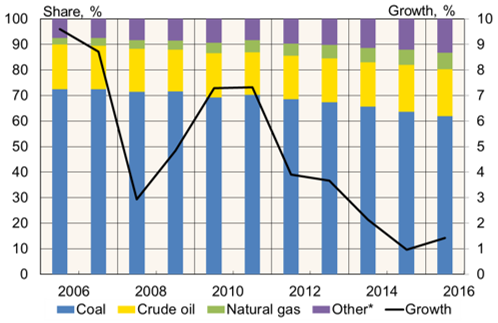BOFIT Weekly Review 48/2017
Coal will still account for over half of Chinese power generation in 2030
China remains heavily dependent on coal. The IEA's latest World Energy Outlook reports that coal accounted for 73 % of domestic energy production in 2016 and 65 % of energy consumption (production and imports). With its current production and consumption structure, China accounts for half of global coal demand, even if it only accounts for roughly a quarter of total global energy demand. Air-pollution problems caused by coal largely drive China's efforts to reduce coal use.
The IEA expects Chinese energy demand to increase by 21 % between 2016 and 2030 if existing plans move forward and announced intentions are fulfilled. Growth is clearly lower than in the 2000–16 period, when demand rose by 180 %. The IEA forecast sees energy demand rising as much as 31 % without effective reforms. Sustainable development would require demand to grow by just 5 %. The report predicts that China's own energy production will increase by just 17 % by 2030, which means the country becomes more dependent on energy imports and remains the world's largest net importer of energy. China's self-sufficiency in oil and natural gas is low and further increases in demand lower China's energy self-sufficiency overall. By 2030, the IEA expects more energy demand to be covered by natural gas (10 %), various forms of renewable energy (13 %) and nuclear energy (6 %). Coal-based production, however, will still satisfy 52 % of energy demand.
Structural reforms of the energy sector require considerable investment, which IEA estimates to reach 200 billion dollars a year by 2025. On top of that, most currently operating coal-fired plants are fairly new (70 % of coal capacity consists of plants commissioned in 2005 or later) and taking them off-stream might mean abandoning of otherwise usable power infrastructure worth roughly 90 billion dollars by 2030.
Structure of China's total energy demand by energy source and annual growth of total demand, 2006–2016

*) Other category (12 % in 2015) includes hydropower (8 %), nuclear power (1 %) and other energy forms.
Sources: China National Bureau of Statistics, CEIC, BOFIT.